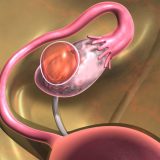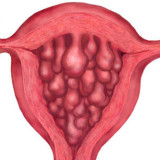
Mucinous cistadenoma takes about 30% of benign ovarian pathology.
The Causes and mechanism of appearance of mucinous cysts are redefined. But a unified theory is still missing. However, there are a number of characteristics.
Features of mucinous cystadenoma.
The Main distinguishing feature of mucinous cystadenoma is a special slimy contents (mucus, lat. – mucus). This is due to the fact that the inner surface of the cyst is covered by a layer of cells, similar in structure to the cells of the cervix that secrete mucus into the vagina. In addition, for mucinous cysts are characterized by the presence of a large number of chambers and baffles that make it easily recognizable in the survey. Often, the disease affects both ovaries, the tumor may reach large sizes. In my practice, I met a cyst the size of more than 40 cm Most mucinous cistadenoma of the ovary occurs in women after 30 years.
Symptoms of mucinous cystadenoma.
As already mentioned, mucinous cistadenoma can reach impressive dimensions. But while the cyst is small in size, the disease usually occurs completely unnoticed, as the first symptoms appear after augmentation. Patients begin to feel nagging pains in the womb, the increase in abdominal size. The growing tumor may compress the bladder and cause frequent urination, or to put pressure on the bowel, leading to constipation.
Diagnose mucinous cistadenomy.
The Main thing when diagnosing this disease is early detection of the cysts. The sooner it’s detected, the more likely you are to save the ovaries and to avoid serious complications. The big role is played by the regularity of visits to the gynecologist. The easiest method of diagnosis of cyst – ultrasound (ultrasound). Due to the described above features of the structure, for an experienced physician diagnosis of mucinous cystadenoma usually presents no serious difficulties, and at the early stages of growth. For large dimensions of the tumor, it is difficult to establish where it comes from. In these cases, there is a need for more accurate and informative diagnostic procedures such as magnetic resonance imaging. Large tumors always guard against cancer, is therefore mandatory blood testing for the level of the ovarian tumor markers (CA-125 and HE4). Often mucinous cysts are associated with diseases of the gastrointestinal tract, so sometimes shown gastroscopy and colonoscopy.
Treatment of mucinous cystadenoma
Treatment of mucinous tumours only surgical. Extent of surgery depends on age, tumor size and condition of the ovaries. At a young age, especially at small sizes cysts should try to keep a little bit of ovarian tissue. It is quite difficult to do, because the whole ovary may be just littered mucinous cysts of varying size. This circumstance leads to the fact that the frequency of removal of the ovary with mucinous cystadenoma remains high. A large number of cameras and the significant size of the tumor often force surgeons to expand online access, moving to an open abdominal surgery. Because when you remove mucinous cysts it is necessary to completely remove the affected tissue without draining the cyst in the abdominal cavity. If the cyst is opened inside the abdomen, this can cause the cells that produce mucus, are deposited between bowel loops. After a while after surgery in the abdomen begins to pile up large amounts of mucus and developed a severe complication called “little”. Fortunately, this occurs rarely, but the surgeon never for a moment forget about him, and do everything possible to prevent this dangerous complications.












